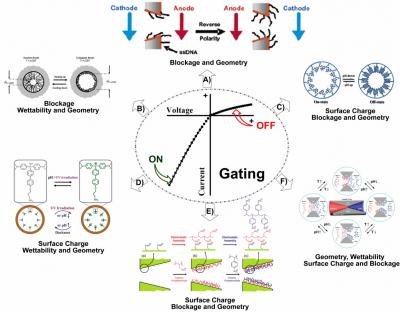Jun 26 2014
Confined water exists widely and plays important roles in natural environments, particularly inside biological nanochannels.
 There are some factors that can influence the transportation in a confined region, including geometry of confined region, blockage, charge and wettability etc. The asymmetrically charged large volume nanostructure with hydrophilicity materials are always helpful in transporting ions, which could help us to design, construct and apply confined water in applications. Credit: ©Science China Press
There are some factors that can influence the transportation in a confined region, including geometry of confined region, blockage, charge and wettability etc. The asymmetrically charged large volume nanostructure with hydrophilicity materials are always helpful in transporting ions, which could help us to design, construct and apply confined water in applications. Credit: ©Science China Press
Professor Lei Jiang and his group from State Key Laboratory of Organic Solids, Institute of Chemistry, Chinese Academy of Sciences, set out to study this unified bionic frontier. After several years of innovative research, they developed a series of biomimetic nanochannels, delivered a strategy for the design and construction of smart nanochannels and applied the nanochannels in energy conversion systems. The author thought the inner surface property was the base for confined transportation. Their work, entitled "Construction of biomimetic smart nanochannels for confined water", was published in National Science Review. 2014, Vol 1 (1).
Nature has always greatly inspired technology, engineering and significant inventions. Through four billion year's evolution, the natural world exhibits all measures of perfect design and intelligence. For example, the lotus can realize the self-cleaning effect using its micro/nano-composite structure. The water striders can walk easily and freely on the water surface via the special micro- and nano-structure on their legs. Similarly, there are numerous functional units that can interact with water molecules in organisms. The protein-based ion channels are the good examples for these functional units, which play important roles in many physiological processes, such as cellular signal transfer, energy conversion, potential adjusting, matter exchange and systemic function adjusting. One remarkable example is the electric eel, which is capable of generating potentials of ~600 V to stun prey and ward off predators with highly selective ion channels and pumps on its cell membrane. Therefore, learning from nature could help us develop smart materials and system.
Bio-inspired from nature, Jiang's group has achieved great research results in water related sciences including two dimensional interfaces with wetting, dewetting and superwetting properties. Based on this work, Jiang and coworkers transferred their research interest to non-aqueous systems, where they focused on the oil wetting property. From this they developed self-cleaning surfaces under water with inspiration coming from fish skin. Recently, Jiang's group focused on the confined water in one dimensional nano-structure materials. The study examined the confined water on the outer surfaces of one dimensional nano-structured materials including spider silk and cactus thorn, which can be used to collect water in air. They also studied confined water existing in nanochannel, which included the construction and application of bio-inspired nanochannels. In this review, Prof. Jiang expatiated the confined water that exists in one-dimensional micro/nano composite structures in detail, particularly inside biological nanochannels. Using these nanochannels as inspiration, they provided a strategy for the design and construction of biomimetic smart nanochannels. Importantly, they have applied the abiotic analogs to energy conversion systems.
The confined water, that is water confined in micro- or mesopores, not only plays an important role in maintaining the existence and development of living organisms, but also concerns the sustainable development of human society. Research results of bio-inspired spider silk and cactus thorn showed the confined water collection on these one dimensional nanostructures was helpful in solving the shortage of freshwater resources. Meanwhile, biological ion channels played key roles for high efficient energy conversion in organisms due to its nanoscale effect and ion selectivity. This perfect unification keeps the material and information transferring effectively with the outside of the organism, which ensures its energy conversion efficiency far beyond the traditional manual energy device. Therefore, inspired by living systems, much effort has been directed toward building the functional unit with nanometer multistage, multiple scale, asymmetric structure, and so on, which can greatly enhance the conversion efficiency helping us to solve the global energy shortage (as shown in the Figure).